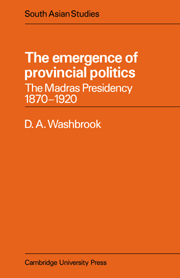Book contents
- Frontmatter
- Contents
- Preface
- Abbreviations, notes on references and spelling
- Introduction
- 1 The Madras Presidency
- 2 The governance of Madras
- 3 The political economy of Madras
- 4 Local structures of political power
- 5 The emergence of provincial politics
- 6 The vocabulary of communal politics
- 7 The Home Rule League, Justice Party and Congress
- Conclusion
- Glossary
- Bibliography
- Index
4 - Local structures of political power
Published online by Cambridge University Press: 21 September 2009
- Frontmatter
- Contents
- Preface
- Abbreviations, notes on references and spelling
- Introduction
- 1 The Madras Presidency
- 2 The governance of Madras
- 3 The political economy of Madras
- 4 Local structures of political power
- 5 The emergence of provincial politics
- 6 The vocabulary of communal politics
- 7 The Home Rule League, Justice Party and Congress
- Conclusion
- Glossary
- Bibliography
- Index
Summary
The British, then, were faced by a series of a strong, local political structures which rested upon the organisation of the economy. Based on the provision of a variety of facilities – for the continuation of production, for social welfare and for the patronage of culturally worthy objects – these structures were extremely hierarchic in orientation. They placed in the hands of a few men means to control the behaviour of many. During the nineteenth century, of course, the British could not destroy these structures and, as it were, build for themselves the type of political society which they would like to administer. They were not prepared to commit themselves to providing directly the same facilities as the various rural–local bosses and magnates – and certainly would not have been able to meet such a commitment had they made it. They had to use the local political systems which were waiting for them in 1800 and which, to a considerable extent, developed independently beneath them through to 1947. Yet, although weak and compromised by the locality, the British were not entirely unable to influence the course of local events. The resources and the powers which they could mark into or erase from the social design did enable them to elongate or foreshorten the patterns which they found. From the later nineteenth century, as it was forced into ever greater activity, Fort St George came to use its rubber and its pencil with increasing regularity. In this chapter, our purpose is to examine the social and political consequences of the ground–level enmeshment of the formal administration with local political structures.
- Type
- Chapter
- Information
- The Emergence of Provincial PoliticsThe Madras Presidency 1870–1920, pp. 146 - 214Publisher: Cambridge University PressPrint publication year: 1976



